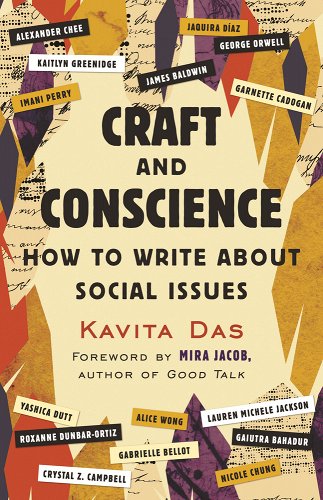 In Craft and Conscience: How To Write About Social Issues (Beacon Press, Oct. 2022), Kavita Das compiles crucial questions all writers should be asking themselves. Inspired by a class she teaches called “Writing About Social Issues,” each chapter is its own lesson, complete with practical advice buttressed by exemplary writing by James Baldwin, Imani Perry, Roxanne Dunbar-Ortiz, Jaquira Díaz, Alexander Chee, Kaitlyn Greenidge, Alice Wong, and others, including numerous essays by Das herself. A question that Mira Jacob poses in her forward encapsulates a theme found in all of the selected pieces: “What will happen to us if we dare call attention to the parts of the system that benefit some at great cost to others?”
In Craft and Conscience: How To Write About Social Issues (Beacon Press, Oct. 2022), Kavita Das compiles crucial questions all writers should be asking themselves. Inspired by a class she teaches called “Writing About Social Issues,” each chapter is its own lesson, complete with practical advice buttressed by exemplary writing by James Baldwin, Imani Perry, Roxanne Dunbar-Ortiz, Jaquira Díaz, Alexander Chee, Kaitlyn Greenidge, Alice Wong, and others, including numerous essays by Das herself. A question that Mira Jacob poses in her forward encapsulates a theme found in all of the selected pieces: “What will happen to us if we dare call attention to the parts of the system that benefit some at great cost to others?”
The book is a useful primer for writers who are newer to writing about social change, regardless of their overall writing experience—in Das’ words, “You—a person of conscience, who may have been hesitant to engage with social issues on the page.” Those steeped in social justice discourse will encounter many familiar concepts and references, all of which can lead to new or deepened insights upon being revisited.
Das encourages self-examination as a vehicle for producing more meaningful—and in some cases more persuasive—writing. She writes, “Writing and social change work are both about transformation. Deeply affecting writing brings about personal transformation through subtle shifts in awareness, perspective, and empathy.”
Craft and Conscience opens with “Why We Write,” a chapter on interrogating motivations. It introduces a central theme: the need for writers to “reflect on who we are as storytellers and how we relate to the issue in terms of our identities.” In doing so, writers must probe how their motivations may feed into existing biases and stereotypes. While this is not Das’ responsibility, per se, I wondered about writers who may not be equipped to do this on their own and the myriad ways well-meaning folks who think they are holding themselves accountable can fall short.
Subsequent chapters delve into:
- the relationship between writer, reader, and subject,
- the use of context versus narrative to shape a story,
- writing from outside (reporting) or inside (personal narrative), and in some cases both (a hybrid approach). As Das notes, “The more a writers’ identity and experience distance them from the issue and community most impacted by it, the more they need to make sure their research involves the perspectives of those most affected.”
Das drills down to the cellular level of decisions that are at once about craft yet are also critical to maintaining a writer’s commitment to their guiding values. At the same time, these chapters contained several instances where binary frameworks were used to present concepts that could have been treated with more nuance.
The many sample pieces Das includes comprise a strong syllabus for further engagement. They tackle difficult issues and model how to grapple with the book’s foundational questions. Das also highlights sections from each sample that illuminate her points within the body of each chapter. This lends a choose-your-own-adventure feel to the book, allowing readers to carve out a personalized educational journey through the provided readings. At times the author’s need to interweave multiple samples within her explanations led to clunky transitions that could have been avoided by going deeper into fewer pieces.
A chapter devoted to the writing of op-eds provides a sample structure and helps writers parse when they are topical experts, when they have valuable lived experience to back up their claims, and when they have both—an ideal combination for the writing of persuasive essays.
A chapter on cultural appropriation (and its antidote as put forth by Das: cultural sensitivity) raises some of the most important questions within the book, and names power as a central issue that undergirds them all. Questions like “Is your understanding of your own identity at the margin or the center of the story?” and “Do you read writers from [the community you wish to write about] currently?” take on added importance when layered with the consideration of power, and its potential imbalance. Das goes on to write, “Cultural sensitivity is a matter of respect for cultural identity but also a matter of good writing craft.”
This served as a culmination of a point that the entire book is making: the ability to write effectively about sociopolitical issues is a craft issue and should be considered as such by all writers and those who teach writing. I have lost count of the number of times I’ve been in a writing class where addressing the lack of cultural understanding has eaten up crucial time where I could have been receiving feedback on my work. Furthermore, editors should view a given writer’s cultural sensitivity as an integral part of their craft, not an add-on or something that only writers from marginalized backgrounds provide.
Craft and Conscience leaves readers with a lot to digest. It will no doubt be read and reread as a crucial reference for writers who seek social change and/or wish to help fellow writers hone their craft. All writers should engage in the self-reflection Kavita Das illuminates. In doing so, they will no doubt produce some of their most meaningful work. To end with Das’ own words, “My deepest hope is that this book invites more writers, emerging and established, to engage social issues in their work, because doing so compellingly yet with integrity is a critical first step in creating social change.”

Anri Wheeler
ReviewerAnri Wheeler is a multiracial writer, antiracist educator, and mother to three strong daughters. Her memoir-in-progress is about race, class, motherhood, and tearing open the boxes into which we’re asked to reduce ourselves. More at anriwheeler.com.


